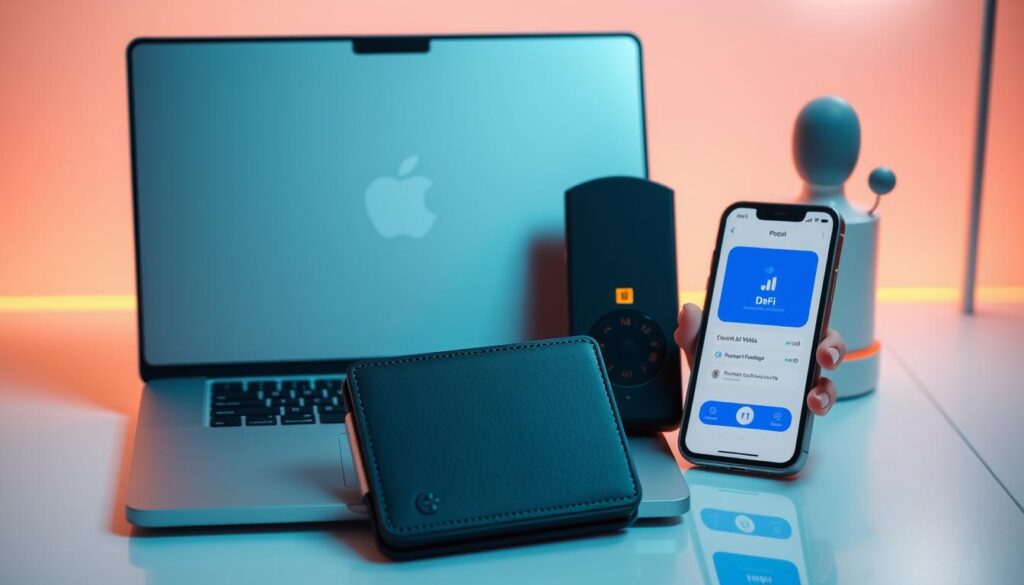Now Reading: How to Use Decentralized Finance Platforms in the USA
- 01
How to Use Decentralized Finance Platforms in the USA
How to Use Decentralized Finance Platforms in the USA

Decentralized finance (DeFi) platforms are changing how Americans handle money, without banks. This guide will show you how to use decentralized finance platforms in the USA. We’ll cover topics like crypto wallets, smart contracts, and following the law.
This guide is for both newbies and those who already know a bit about DeFi. We’ll talk about the legal side, like SEC rules and state laws. You’ll learn how to start safely, from setting up a wallet to making your first trade. We’ll also share tips to avoid common mistakes.
Key Takeaways
- Understand core DeFi concepts and their differences from traditional banking systems.
- Discover how to comply with U.S. regulations while accessing DeFi services.
- Explore step-by-step guidance for setting up wallets and initiating transactions.
- Learn tax reporting requirements for DeFi activities in the U.S.
- Identify security measures to protect assets on platforms like Uniswap or Aave.
Understanding Decentralized Finance and Its Growth in the United States
Decentralized finance, or DeFi, is a big change from old banking systems. It uses blockchain technology. Decentralized finance platforms let users get loans, trade, and save without middlemen. This means people can manage their money on their own, unlike before.
What Is DeFi and How Does It Differ from Traditional Finance?
DeFi is all about being open and easy to use. Unlike old finance, DeFi doesn’t need bank approvals. Anyone with internet can use decentralized finance platforms with digital wallets. No need for credit checks or scores.
The Evolution of DeFi Platforms in the American Market
DeFi started in America with Ethereum-based projects like Uniswap and Aave. Now, it’s on many blockchains. Americans can do things like yield farming, create liquidity pools, and lend directly to others. This shows more people want to use blockchain for their money needs.
Key Benefits of Using Decentralized Finance Systems
- Higher yields: Make more money through staking or providing liquidity, often more than savings accounts.
- 24/7 access: Trade or do transactions anytime, not just when banks are open.
- Inclusivity: Over 6 million people without bank accounts can join in, no credit checks needed.
As decentralized finance in America grows, it changes how people manage their money. It brings control and new ideas to finance.
Legal and Regulatory Framework for DeFi in the USA
Understanding DeFi in the USA means knowing both federal and state rules. Agencies like the SEC, CFTC, and IRS are making rules for decentralized finance. This is despite its decentralized nature.
Current Regulatory Status of Decentralized Finance
Federal regulators are setting rules for DeFi. The SEC says some DeFi is like securities, needing to follow certain rules. FinCEN also has rules for crypto transactions, affecting how platforms work in the USA.
SEC Regulations and Their Impact
- The SEC has taken action against projects seen as unregistered securities. This has led to fines for those who don’t follow the rules.
- There’s also new guidance about the dangers of unregistered DeFi platforms.
- Platforms must do KYC checks, even in decentralized systems.
State-by-State Regulatory Differences
States have their own rules for DeFi:
- Wyoming: It’s been a leader with laws friendly to blockchain, allowing DAOs to operate legally.
- New York: It requires BitLicense compliance for platforms serving its residents.
- California: It focuses on protecting consumers, banning some yield farming incentives.
Compliance Tips for Users
To follow the rules:
- Check if the platform has a license in your state.
- Keep track of all transactions for IRS Form 1040 reporting.
- Choose platforms that clearly follow KYC protocols.
Essential Tools and Requirements for Accessing DeFi Platforms
Americans need to get the right tools before diving into DeFi platforms. You’ll need modern devices and updated software. Also, a fast and reliable internet connection is key for smooth transactions.
It’s important to know about network fees to avoid unexpected costs. This knowledge helps you plan your transactions better.

For DeFi tools for Americans, you’ll need browsers like Chrome or Brave. Add MetaMask or Trust Wallet extensions for extra security. If you’re using a mobile, make sure your app follows US laws.
Gas fees can change, so it’s smart to check before you start. This way, you won’t be surprised by costs.
- Two-factor authentication (2FA) for all accounts
- Hardware security keys (e.g., YubiKey)
- Network monitoring tools like Etherscan or DeFi Pulse
Understanding key terms like gas, slippage, and impermanent loss is crucial. Gas fees affect how fast your transactions are. Higher fees mean quicker processing.
Slippage impacts how accurate swaps are on decentralized exchanges. Impermanent loss risks are for those providing liquidity. Make sure you’re well-prepared with the right tools and knowledge to safely explore DeFi.
Setting Up Your First Crypto Wallet for DeFi Interactions
Before you start with decentralized finance in America, you need a secure crypto wallet. This digital safe keeps your keys to access places like Uniswap or Aave. You can pick between hardware or software wallets, depending on what you need.
Hardware vs. Software Wallets for American DeFi Users
Hardware wallets, like Ledger and Trezor, keep your assets offline. This makes them safer from hackers. They’re great for keeping large amounts of money safe. On the other hand, software wallets—like MetaMask, Trust Wallet, or Coinbase Wallet—are easy to use on phones or computers. But, you have to be careful to avoid phishing scams.
- Hardware: Cold storage, best for long-term savings
- Software: Easy daily use but needs strong 2FA
Securing Your Private Keys and Recovery Phrases
- Write recovery phrases on fireproof materials, never digitize
- Store keys in safe deposit boxes or encrypted files
- Disable public Wi-Fi when accessing wallets
Connecting Your Wallet to DeFi Applications
To link wallets to platforms, use browser extensions or mobile apps. Always:
- Verify URLs match official DeFi sites
- Use wallet connect protocols to approve transactions
- Limit third-party app permissions
A well-set-up wallet protects your journey into decentralized finance in America. It makes sure your DeFi interactions are smooth and safe.
How to Use Decentralized Finance Platforms in the USA Step-by-Step
Starting your DeFi journey requires clear steps. Here’s how to move from setup to execution seamlessly.
Creating an account on utilizing DeFi platforms often involves a two-step process. While DeFi protocols themselves don’t require IDs, many front-end apps ask for KYC details when accessing regulated on-ramps like Coinbase. Verify your identity through email and ID uploads to unlock full functionality. Always confirm account creation by checking transaction history and wallet balances.
Funding Your Wallet with Cryptocurrency
Choose from these methods to add funds:
- Buy crypto via exchanges (e.g., Kraken, Binance.US) using bank transfers or credit cards
- Peer-to-peer trades on platforms like LocalCryptos
- Crypto ATMs located in 49 U.S. states
Compare fees—Coinbase charges 1-3% for card purchases, while P2P trades often cost less.
Navigating Platform Interfaces
Look for these core features:
- Liquidity pools show available assets for swaps
- Yield rates displayed in APY percentages
- Risk alerts for volatile pairs
Always preview transactions before finalizing.
Executing Your First DeFi Transaction
Follow this sequence to complete a swap:
- Select the asset pair (e.g., ETH to USDT)
- Input amount while checking slippage (1-3% is standard)
- Review gas fees on Ethereum or layer-2 networks like Arbitrum
- Confirm via your hardware wallet’s screen
Verify success by tracking the transaction on block explorers like Etherscan.
Each step ensures safe interaction with decentralized systems. Stay alert to fee fluctuations and protocol updates for optimal results.
Exploring Different Types of DeFi Services Available to Americans
DeFi services in the USA offer a range of financial tools. They help users earn interest, trade assets, and more. These platforms follow U.S. rules but offer decentralized solutions.

- Lending/Borrowing: Aave and Compound let users lend crypto assets to earn interest or borrow funds by posting collateral.
- Decentralized Exchanges (DEXs): Uniswap and SushiSwap enable direct peer-to peer token swaps without centralized intermediaries.
- Yield Aggregators: Yearn Finance automates yield farming strategies across platforms to optimize returns.
- Derivatives Trading: dYdX and Synthetix offer futures contracts and synthetic assets for advanced trading.
- Risk Management: Nexus Mutual provides insurance against smart contract failures to protect funds.
- Portfolio Tools: Set Protocol automates portfolio creation using pre-built crypto investment strategies.
Users often mix services to manage risk and returns. For instance, lending on Aave and trading derivatives on dYdX to protect against losses. Platforms like Uniswap and Compound meet U.S. compliance, making them accessible to residents. These DeFi services in the USA are for both new and experienced users. They aim to give users control over their finances without traditional banking.
DeFi Lending and Borrowing: Maximizing Your Crypto Assets
DeFi platforms let US users make money from their crypto. By putting assets like ETH or USDT into pools on Aave or Compound, you can earn interest. The interest rates change based on how much is available and how much people want to borrow.
There are different types of rates. Variable rates can change, offering more or less interest. Fixed-term rates give you a set amount of interest, making it easier to plan your earnings.
- Compare APY rates on platforms like MakerDAO’s CDP or Euler Finance
- Monitor token liquidity to avoid impermanent loss risks
- Claim platform-specific governance tokens for yield boosts
Borrowers can get funds by using crypto as collateral. They usually need 150-200% of the loan value. For instance, if you have $10,000 worth of BTC, you might borrow up to $5,000 in stablecoins.
People borrow for different reasons. They might use it for:
- Margin trading to make their trades bigger
- Getting quick cash without selling their assets
- Getting more yield by rebalancing their portfolios
It’s important to manage risks. The ratio of collateral to debt can trigger a forced sale. If your health factor is 130%, your assets will be sold if they fall below 130% of your debt. Use tools like DeFi Pulse or LoanScan to:
- Set alerts for price changes
- Adjust your collateral during market changes
- Avoid too much debt during tough times
Always check the rules of each platform. Some platforms have stricter rules for assets like NFTs. Finding the right balance between earning more and managing risks is key to growing your assets.
Decentralized Exchanges: Trading Crypto Without Intermediaries
Decentralized exchanges (DEXs) let US users trade crypto directly with each other. They cut out the need for traditional middlemen. DeFi platforms in the USA like Uniswap, SushiSwap, and 1inch are very popular. These platforms allow users to swap tokens quickly or earn rewards by providing liquidity.
Newer options like QuickSwap and TraderJoe offer lower fees. They work on Layer 2 networks, making them great for those watching their costs.
Popular DEXs for US Residents
- Uniswap: Best for Ethereum-based swaps with automated liquidity pools
- SushiSwap: Offers yield farming opportunities alongside trading
- Curve Finance: Specializes in stablecoin pairs for minimal slippage
- PancakeSwap: Operates on BNB Chain for faster, cheaper transactions
Swapping Tokens and Providing Liquidity
Swapping tokens means picking the assets you want to trade and confirming the deal. Liquidity providers (LPs) put token pairs into pools to earn fees. For instance, adding ETH/USDC to Uniswap’s pools can earn rewards but also risks impermanent loss if prices change.
Optimizing Costs on DEXs
Gas fees on Ethereum can go up when lots of people are using it. EthGasStation helps track these fees in real-time. This way, users can plan their trades when fees are lower. Switching to Layer 2 networks like Polygon or Arbitrum can also save money. Always check your slippage tolerance settings to avoid unexpected price changes during swaps.
Tax Implications of DeFi Activities for US Citizens
Every transaction on using DeFi platforms brings tax duties. The IRS views DeFi actions as regular financial events. For instance, swapping tokens or earning yield leads to capital gains or income. A tax guide shows that even airdrops or staking rewards must be reported. It’s crucial to keep track of every transaction.

Tracking DeFi Transactions for Tax Reporting
DeFi users face unique tracking challenges. Swaps, liquidity pools, and loans occur across multiple chains. Tools like blockchain explorers and CSV exports help log activity. Key taxable events include:
- Token swaps on decentralized exchanges
- Liquidity provision rewards
- Borrowing costs and repayments
- Airdropped governance tokens
Common Tax Pitfalls When Using Decentralized Finance
Mistakes often come from not understanding tax rules. Avoid these errors:
- Ignoring airdrops as taxable income
- Overlooking wrapped token conversions as sales
- Miscalculating cost basis during cross-chain transfers
- Forgetting to report small trades
Tools for DeFi Tax Compliance
Specialized software makes reporting easier. Solutions like Koinly and TokenTax auto-import transactions from platforms like Uniswap or Aave. These tools generate IRS Forms 8949 and 1040 schedules. Always double-check calculations with a tax professional.
Keep up with IRS guidance on crypto transactions. Professional help ensures accuracy when using DeFi platforms. Staying compliant protects against penalties and helps maximize deductions.
Security Best Practices When Engaging with DeFi Platforms
Keeping assets safe in decentralized finance in America needs careful steps. Choose secure wallets like Ledger or Trezor for big amounts. Keep funds in cold storage, not in hot wallets online unless you’re trading.
Make sure to check platforms before putting in your money. Look for third-party audits on sites like Etherscan. Also, check for clear code and community rules. Don’t invest in projects without audits or if they seem too quick.
- Use two-factor authentication on all exchanges and wallets
- Enable email alerts for large transfers
- Update software regularly to patch vulnerabilities
Watch out for scams in America. Phishing sites look like real DeFi sites—always type URLs yourself. Don’t believe promises of more than 100% returns. Check token requests carefully to avoid losing money. Use Revoke.cash to remove old permissions.
If you’re hacked, cut off affected devices and tell exchanges. Freeze your accounts and reach out to crypto recovery services like Chainalysis. Tell the FTC at ftc.gov/complaint about the issue.
In decentralized finance in America, there’s no help for lost money. Every action is high-risk—security is up to you.
Advanced DeFi Strategies for Experienced Users
If you’re good at utilizing DeFi platforms, you can get better returns and lower risks. Here are some ways to make your crypto portfolio better:
Yield Farming Opportunities
Yield farming can help you earn more by moving assets between protocols. These protocols give out tokens as rewards. It’s important to keep track of APY calculations and watch out for losses and fees. Yearn.finance and Cream Finance are good options for those in the U.S.
- Compare APY rates across platforms to avoid hidden costs
- Monitor reward token volatility to lock in profits
- Use rebalancing tools to automate portfolio adjustments
DeFi Insurance Solutions
Use insurance to protect your investments. Companies like Nexus Mutual and Cover Protocol offer this service. They cover losses from smart contract hacks. The cost of insurance depends on how much you want to cover, and you need proof of loss to claim.
Make sure to check what’s not covered, like certain protocols or expired policies.
Cross-Chain DeFi Strategies
Explore other networks like Solana, Avalanche, and Polkadot. Here’s how:
- Bridge assets via services like Wormhole or cBridge
- Manage multi-chain wallets like MetaMask or Trust Wallet
- Research each ecosystem’s gas fees and security audits
Always check the audit reports and liquidity pools of cross-chain bridges before transferring assets. It’s key to balance risk and reward by watching network-specific metrics like TVL (Total Value Locked).
Common Challenges and How to Overcome Them When Using DeFi in America
Using DeFi platforms can be tough for Americans, with technical and market issues. But, DeFi tools for Americans can help make things easier. First, tackle geo-restrictions. Some platforms don’t allow U.S. users due to rules.
Use tools like DeFi tools for Americans DeFi Pulse or 1inch to find apps that work in your area. You can also use VPNs to get around location blocks, but check if they work with the platform first.
Technical problems like failed transactions can happen due to network issues or wrong settings. Check gas fees on Ethereum-based platforms with ETH Gas Station. For bridging errors, use trusted bridges like Polygon or Arbitrum to avoid scams.
Wallet connection issues? Try restarting your browser and make sure MetaMask or Trust Wallet is updated.
Liquidity problems? Choose platforms like Aave or Cream Finance that need low deposits. Use stablecoins like USDC or DAI to lower risk. Dollar-cost averaging tools like DeFi tools for Americans BlockFi or Swan Bitcoin help spread out investments. Use DeFi dashboards like DeFiLlama to keep an eye on everything at once.
- Gas cost challenges: Use layer-2 networks like Optimism or Arbitrum for cheaper fees
- Interface confusion: Join Discord communities of platforms like Uniswap or SushiSwap for real-time support
- Liquidity shortages: Explore niche platforms like Compound or dYdX for smaller portfolios
To deal with volatility, pair risky assets with stablecoins using Curve Finance. Always check smart contracts on platforms like Etherscan before using them. By using these DeFi tools for Americans, users can overcome obstacles and grow their crypto safely.
Taking Your Next Steps in the Decentralized Finance Ecosystem
Learning more is crucial for mastering decentralized finance in the United States. Look into free courses on platforms like Coursera or ConsenSys Academy. These can help you build a strong foundation.
Join communities on Discord or Reddit for American DeFi users. Here, you can share knowledge and keep up with the latest news.
Start with simple actions like staking stablecoins on Aave or Yearn.finance. This is a low-risk way to begin. Keep an eye on regulatory changes through the SEC and The Block Research. This ensures you stay compliant with new laws.
Follow new trends like decentralized identity solutions from uPort or real-world asset tokenization on Tzero. Joining DAOs like MakerDAO or Compound Governance forums lets you influence the sector’s future.
Always focus on security by checking protocols with DeFi Safety and using Ledger wallets. Begin small, track your progress with DeFi Pulse, and grow your involvement as you learn more. The decentralized finance scene in the United States is constantly evolving, offering chances for those who stay informed and take small steps.
FAQ
What are the essential tools needed to start using decentralized finance platforms in the USA?
To start with DeFi in the USA, you need a device like a smartphone or computer. Make sure it has a secure internet connection. You’ll also need a crypto wallet, browser extensions like MetaMask, and security tools like VPNs and two-factor authentication.
How do I create and verify my account on a DeFi platform?
To create an account, download a wallet app and set it up. Some DeFi platforms might ask for verification, like KYC, due to laws. Always share only the necessary info and check if the platform is legit before you start.
What are the legal considerations for using DeFi platforms in the USA?
DeFi users in the USA face a complex set of laws from the SEC and IRS. You need to know about compliance, including KYC and taxes on transactions. Make sure to check both federal and state laws to avoid legal issues.
How can American users ensure their DeFi transactions are secure?
For security, use hardware wallets for big amounts and check the platform’s security audits. Also, manage smart contract permissions carefully. Always be on guard against scams like phishing and fake airdrops to keep your assets safe.
What types of DeFi services are accessible to Americans?
American users can use many DeFi services. These include lending and borrowing (like Aave, Compound), decentralized exchanges (Uniswap, SushiSwap), and insurance (Nexus Mutual). Each service has its own rules and needs to be understood well.
How do I manage gas fees when using DeFi platforms?
Gas fees can change a lot based on network activity. To manage them, choose less busy times for transactions. You can also use Layer 2 solutions or other blockchains with lower fees. Knowing gas patterns can help lower your costs.
What are the tax implications of engaging with DeFi in the United States?
Every DeFi transaction can have tax effects. You need to track your transactions closely. Use crypto tax software to report taxable actions to the IRS accurately.
How can I overcome challenges when using DeFi in America?
Challenges include access issues and technical problems like failed transactions. Use VPNs for access and find troubleshooting resources for tech issues. Managing volatility, like using stablecoins, can also help.













